Affiliate disclosure: This post may contain affiliate links. Please see our Privacy Policy.
Cherry wine is a beautifully sweet way to use up a bumper crop of fruit this summer.
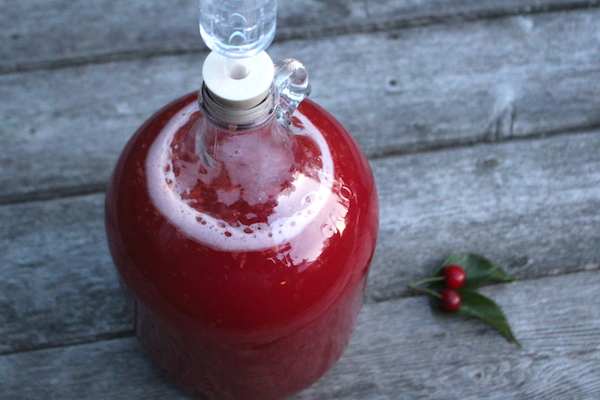
Fresh cherries are a beautiful thing, but they won’t last long. Growing up in California, we’d gorge on pounds of them fresh every day in season, but still, there’s no end to the cherry harvests.
Not living in Vermont, we grow what’s known as “tart cherries” or “pie cherries” which are packed with cherry flavor. As their name suggests, they’re quite tart eaten out of hand.
They’re perfect for preserving, and they make an exceptional cherry wine. (Don’t worry, you can substitute any cherries in this recipe.)
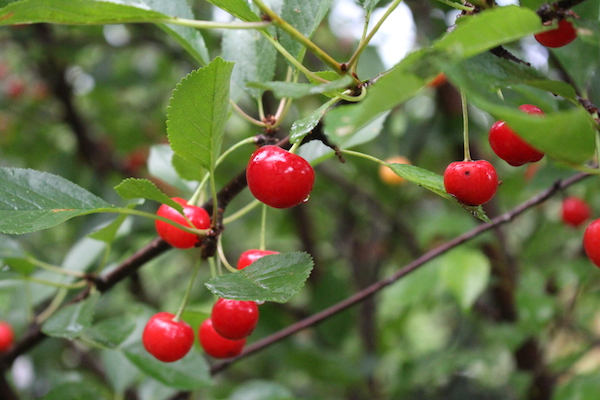
Extracting Juice for Cherry Wine
Generally, when I’m making fruit wine, I let the sugar do the work of juicing the fruit. Just muddle the sugar together with the fruit and it’ll naturally draw the juice right out.
I used this technique for making peach wine and strawberry wine this past year. That technique would work just fine with cherries.
Start by mashing the fruit and sugar together with a potato masher (pitted or whole, no matter). Make sure it’s well mashed to open up the cherry skins. (Don’t use a food processor, damaging the pits will result in a bitter wine.)
Allow the fruit to macerate in the sugar for at least 24 hours, then strain through a jelly bag or cheesecloth.
Alternately, if you’ve pitted the fruit, just place the fruit and sugar into a fermentation bucket and leave them in for the primary.
This time though, I’d just bought a steam juicer to help with the big batches of black currant jelly we make every year. The cherries came ripe shortly after, so I decided to juice the cherries with my new toy.
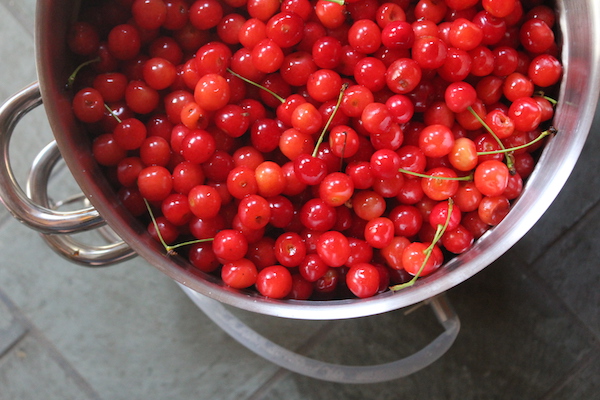
I started with exactly 10 pounds of cherries in the juicer, which is more than you’ll need in this cherry wine recipe.
After about 90 minutes of slow steaming, the cherries had completely released their juices. The draw-off tube allowed me to harvest the juice without any messy straining or cheesecloth.
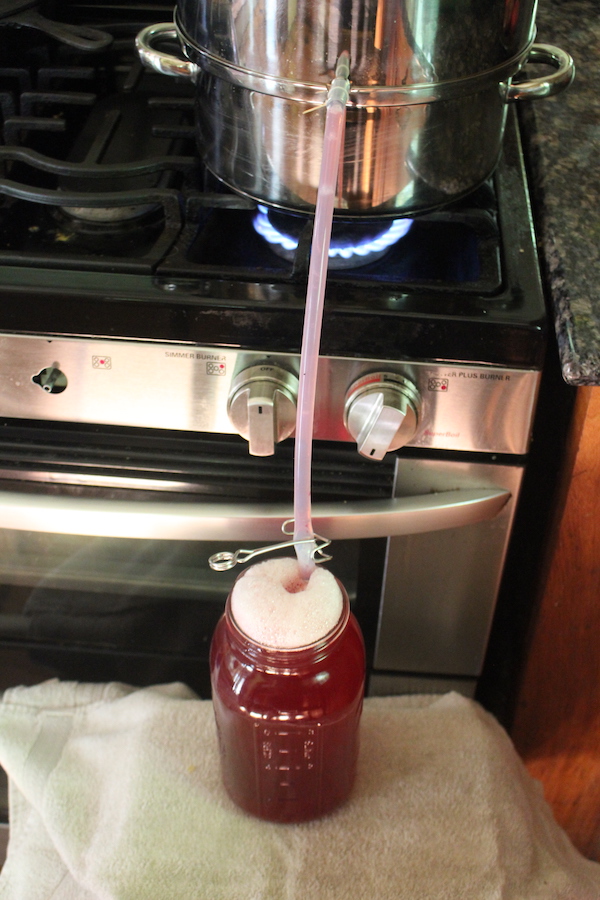
I was able to collect a full gallon of juice from 10 pounds of cherries. As I said, this is more than you’ll need for cherry wine.
Though this is a one-gallon cherry wine recipe, there are other things that need to be added into the carboy. Cherries don’t have nearly as much sugar as wine grapes, so you’ll need to add sugar.
Cherries also lack the right balance of tannins and acid to make a well-rounded wine, so I’m adding a bit of tannin powder and acid blend powder.
If you’d like to make cherry wine without buying any winemaking additives, there are substitutions outlined in the article I wrote on making small-batch wine. For example, lemon in place of acid blend and black tea in place of tannin.
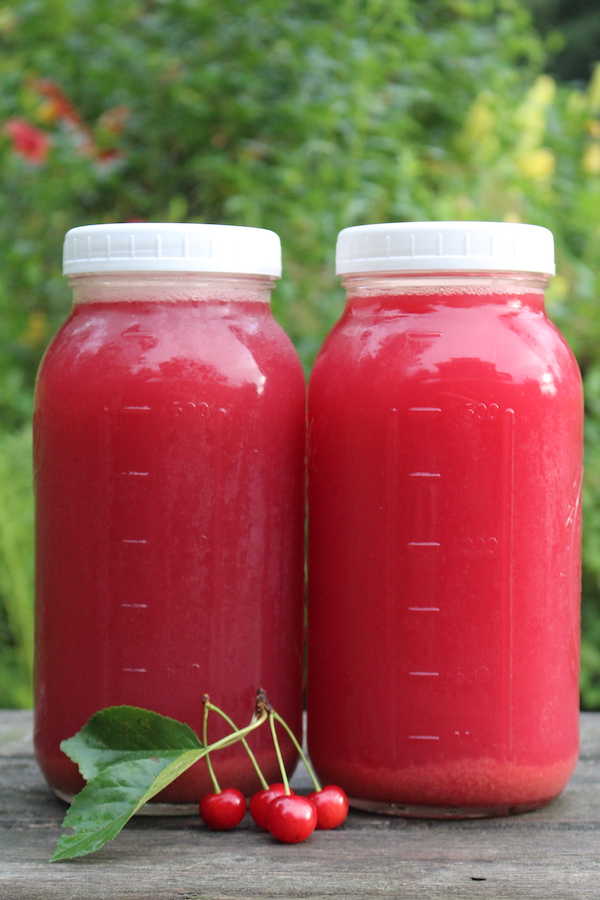
How Much Fruit is Needed for Cherry Wine?
I started by removing one quart of the juice, and I set it aside to make cherry jelly. That left me with 3 quarts of cherry juice.
Assuming you’re not interested in making cherry jelly, starting with 6-8 pounds of fruit would work just fine. Many recipes start with 5 pounds of fruit, and I’d say it’ll depend on the flavor of your cherries.
Black cherries have a more intense flavor, with a rich wine-y note. Tart cherries contain a lot more water and most sour cherry jam recipes involve nearly an hour of cooking to cook them down.
I suggest starting with 6-8lbs of tart cherries, or 5-6 pounds of sweet black cherries.
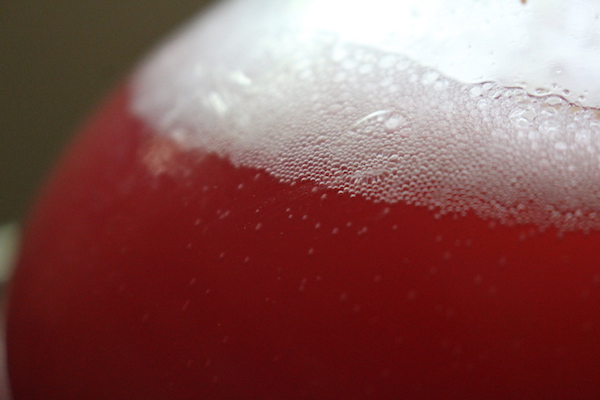
How to Make Cherry Wine
Start by extracting the juice from fresh cherries. This can be accomplished in a number of ways, including:
- Using a juicer
- Muddling the fruit with sugar
- Freezing then thawing the fruit
- Using a Steam Juicer
Place the juice in a carboy and add the winemaking additives. I’m using sugar, tannin powder, yeast nutrient, and acid blend.
Tannin powder helps improve the mouthfeel of the wine and rounds out the taste.
Yeast nutrient helps the yeast thrive since cherries don’t contain all the same nutrients as grapes.
The acid blend brings out the natural sweetness of the fruit and adjusts the pH to help the fermentation proceed smoothly. Sour cherries have a ph between 3.1 and 3.6, while sweet cherries are 3.7 to 4.5. If you’re using sour cherries, adding acid is optional, and if you choose to include it, use only 1/4 to 1/2 as much.
Sugar, of course, feeds the yeast and raises the alcohol content so the wine will keep and adds residual sweetness.
Everything goes into a fermentation vessel, along with a small amount of water to fill if necessary. Add the yeast and cap with a water lock as they go to work.
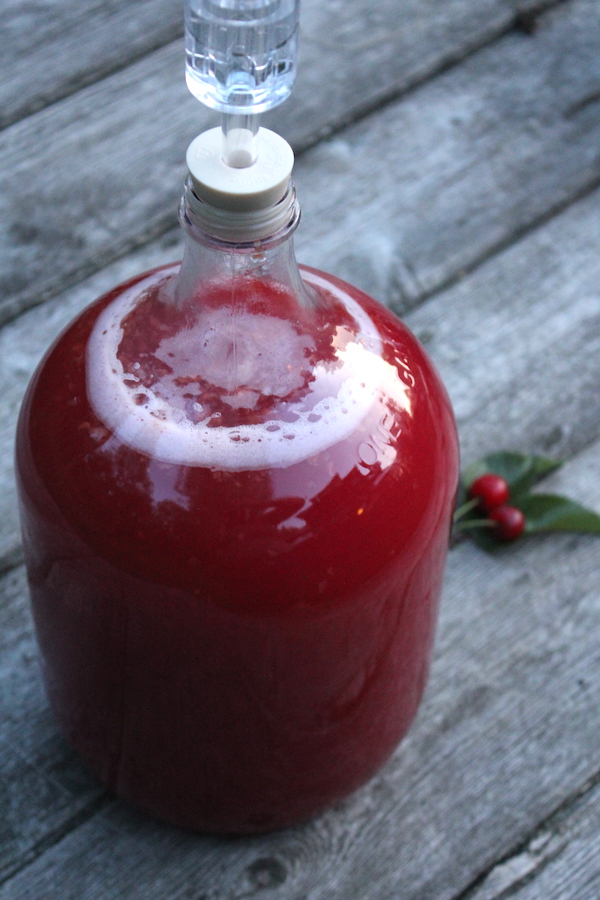
Allow the cherry wine to ferment in primary for one to two weeks until vigorous fermentation has slowed.
After the wine has calmed, use a siphon to rack the wine over into a clean fermentation vessel, leaving the sediment behind. If you left the whole cherries in the fermenter (using a wide mouth bucket fermenter to avoid clogs and make cleanup easier), then this is the time to remove the fruit.
Siphoning will kick off the second round of fermentation.
Allow the cherry wine to ferment in secondary for 4 to 6 weeks (or longer). Once the fermentation is complete, bottle the wine in wine bottles with corks and allow the mixture to bottle age for at least a month (preferably longer) before drinking.
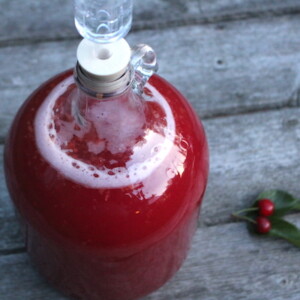
Cherry Wine
Ingredients
If using Sweet Cherries (Black Cherries)
- 5-6 lbs Black Cherries
- 2 lbs sugar
- 2 tsp acid blend
- 1 tsp yeast nutrient
- 1/8 tsp tannin powder
- 1 packet wine yeast, See notes
If using Sour or Tart Cherries
- 6-8 lbs Tart Cherries
- 2 1/2 lbs sugar
- 1/2 to 1 tsp acid blend, optional
- 1 tsp yeast nutrient
- 1/8 tsp tannin powder
- 1 packet wine yeast, See Notes
Instructions
- Sanitize all equipment before beginning with one step brewing sanitizer.
- Juice the cherries (see note) and then dissolve the sugar in about 3 quarts of juice. Stir until completely dissolved (heating is usually not necessary).
- Add the remaining winemaking additives, including acid, tannin and yeast nutrient. Place the mixture into a one-gallon fermentation vessel (narrow neck carboy).
- Dissolve the wine yeast in a small amount of water and allow it to bloom for about 10 minutes. Add the yeast mixture to the carboy.
- Add water (or more cherry juice) to fill.
- Cap with a water lock and allow the mixture to ferment for 1-2 weeks in primary until vigorous fermentation has slowed. If the mixture bubbles up into the water lock, remove it, clean it out and re-apply.
- Rack the cherry wine into a clean carboy, leaving the sediment behind. Re-cap with a water lock and allow the mixture to ferment for another 4 to 6 weeks (or longer).
- Bottle the cherry wine in wine bottles and bottle age for at least a month (or longer) before opening.
Notes
- go through a steam juicer (about 90 min)
- be frozen then thawed (a few days start to finish)
- be gently mashed with sugar to extract their juices into a sugar syrup, being careful not to damage the pits (about 24 to 48 hours)
Montrachet yeast (Red Star Premier Classique)
Premier Blanc (Champagne Yeast) Fruit Weights ~ If buying fruit at the farmer's market, a quart box of cherries weighs about 1.5lbs.
Nutrition
Nutrition information is automatically calculated, so should only be used as an approximation.
More Summer Winemaking Recipes
Hoping to make another batch? Fill your carboy with these…
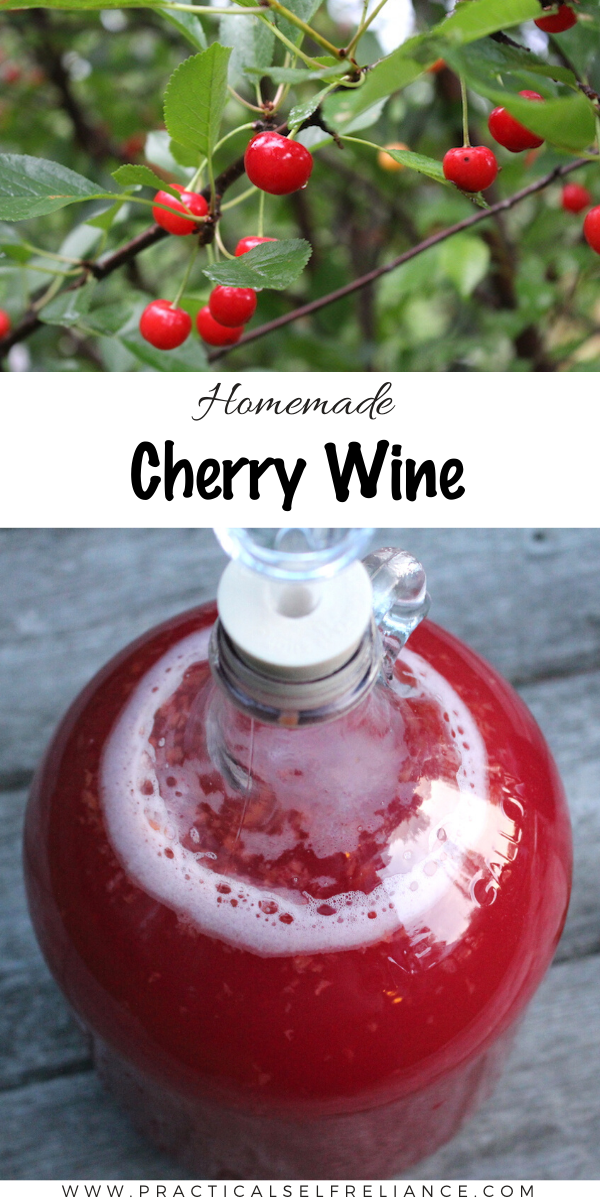


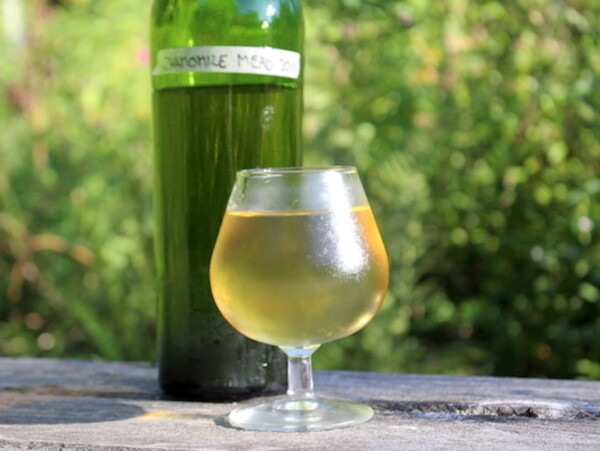
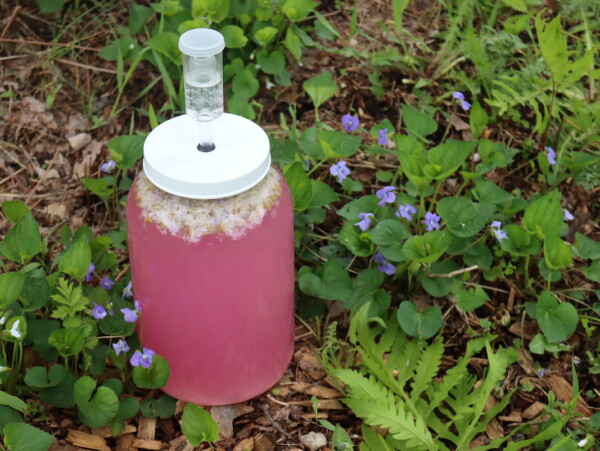
Best ever it made me feel like winter winner chicken dinner
I just finished racking a 1 gallon sour cherry wine I made using the recipe above. I tasted the batch and it was very sweet for my liking. Will this mellow in the secondary fermentation process? To achieve a drier wine in the future, would one add less sugar at the beginning? Thank you!
Yes, you can use less sugar for a drier wine.
Hi Ashley,
You advised me on another post this past fall to follow your cherry wine recipe for white currant wine making. I see you made your cherry wine by using a juice steamer which I do have buy haven’t used yet. I also see conflicting info online in general about putting the pulp back in the juice for the first batch. Is this a good idea?
I guess I am debating using the juice steamer vs letting the currants thaw out vs mashing gently with sugar –seeds in currants could be an issue (bitter)? I want to get the best juice product and not sure what to do.
I assume I should follow the tart cherry recipe vs the black cherry ?
I appreciate any advice 😉 Thank you in advance!!
If I am going to use the juicer then I prefer not to have the extra trouble and mess of straining later so I personally wouldn’t add the pulp back in but I’m curious to know if this affects the flavor or not. If you have the juicer, I would say use the juicer and don’t mess with the pulp. And yes I would probably use the tart cherry recipe.
I canned some cherries using a light syrup. After putting the cherries in the jars I had a quart of ‘cherry syrup’ left over. Can I use that to make wine?
I’m not sure how that would work since the syrup is water and cherry juice rather than straight juice and there isn’t a good way to measure the sugar ratio but it’s certainly worth trying if you want to experiment.